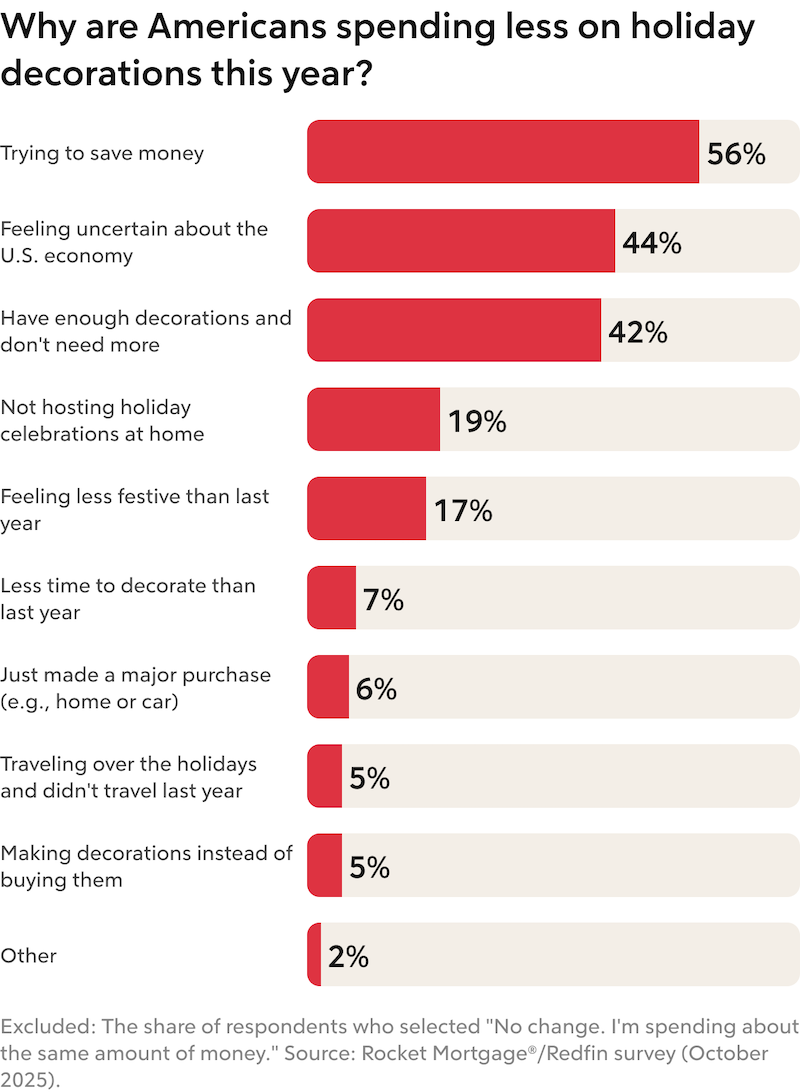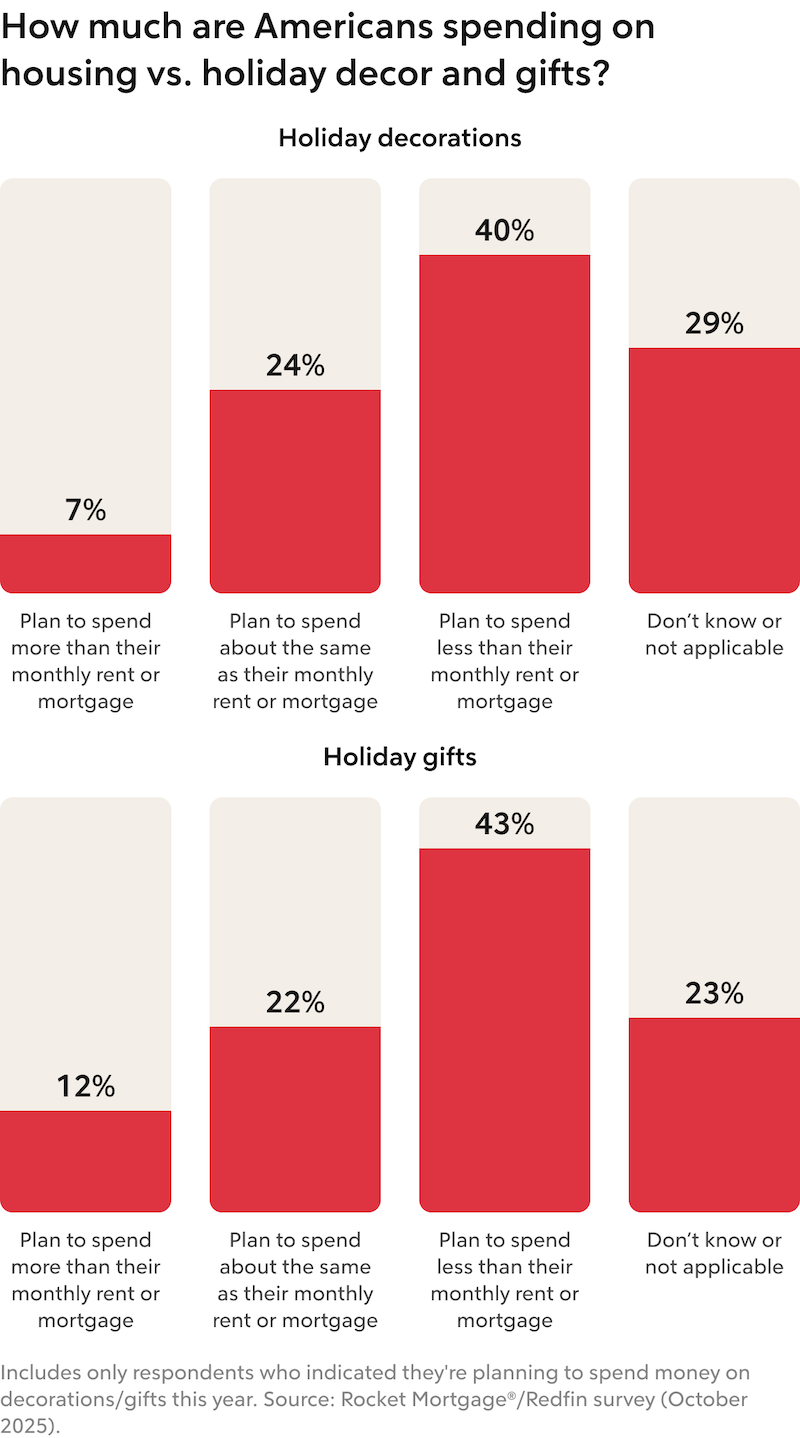Americans are spending less on holiday decor, gifts as economic uncertainty ramps up
Contributed by Grace Lin, Sarah Henseler
Nov 13, 2025
•8-minute read

Holiday cheer is colliding with financial fear, with 28% of Americans trimming their decorating budgets this year and 26% reining in gift spending, according to a new Rocket Mortgage® and Redfin survey conducted by Ipsos.
The pullback isn’t due to a lack of holiday spirit. It's a sign of the times, with many people choosing to spend cautiously amid economic uncertainty.
Still, most Americans are shelling out at least some money on decor and gifts, with many of them reporting they’re decking their halls to celebrate the season and make their home feel festive for family and friends.
Key takeaways:
- 56% of people who report spending less on decorations this year say it’s because they’re saving money, while 44% cite economic uncertainty.
- Roughly one-quarter of Americans are shelling out just as much on decor as their monthly housing payment.
- Most Americans are spending less than $100 on decor this year, and the lion’s share is spending between $100 and $500 on gifts.
- Thanksgiving weekend is the most popular time of year to decorate, and January 2-10 is the most common time to take down the tinsel.
28% of Americans are spending less on decor this year, and 26% are reducing gift budgets
Nearly one-third (28%) of Americans are spending less money on holiday decorations this year than last year, while just 16% are spending more, according to a new Rocket Mortgage and Redfin survey conducted by Ipsos.
People are also cutting back on gift spending. Just over one-quarter (26%) of Americans are spending less on gifts than they did last year, while 18% are spending more.

Budgeting, economic woes are driving Americans to trim holiday budgets
More than half (56%) of those who are spending less on decorations this year say it’s because they’re trying to save money, while 44% cite economic uncertainty.
The next-most common reasons: 42% have enough decorations and don’t need more, 19% aren’t hosting holiday celebrations, and 17% are feeling less festive than last year.

Economic uncertainty has shrouded the U.S. this year, with tariffs, inflation, job insecurity, and recession nerves making many Americans feel financially unstable.
More than 2 in 5 American workers reported delaying or canceling a major purchase like a home or car due to concerns about job security, according to an August 2025 Redfin survey, and 24% of Americans reported canceling a major purchase because of the new tariffs that went into effect in April, per a separate Redfin survey. Additionally, 21% of Americans delayed a major purchase because of the government shutdown, with another 15% canceling a major purchase altogether.
“Even small cost-saving measures, like cutting back on buying new holiday decor, reflects a broader feeling of caution when it comes to the economy,” says Daryl Fairweather, Chief Economist at Redfin. “People are worried about earning less money while costs go up. Americans are keeping their wallets close not because they don’t want to celebrate, but because they’re being sensible. The fact that some people are cutting back during the holidays could be a sign that consumer spending will slow down in the new year.”
People with kids are most likely to spend more on the holidays this year
Americans with children living under their roof are among the most likely groups to spend more on the holidays this year than last year. More than one-quarter (26%) of people with kids living at home are spending more on decorations, and 27% are spending more on gifts.
People without kids living at home are much less likely than their counterparts to be spending more this year. Just 11% of that group is shelling out more this year on decorations, and 14% are spending more on gifts.
Some Americans are spending as much on decorations as housing
Even though Americans are spending less on the holidays this year, some of them are putting just as much money toward decorations or gifts as housing.
Among those who are spending money on holiday decorations or gifts this year, roughly one-quarter (24%) are shelling out the same amount as they are on their monthly mortgage or rent payment. Another 7% are spending more on decorations than their monthly housing payment.
And among those who are spending money on decorations or gifts, 22% are dropping just as much on gifts as their monthly housing payment, while another 12% are spending more on gifts.
Still, many of the people who are spending money on either decorations or gifts this year are spending less than their housing payments. Two in five (40%) are spending less on decor than housing, and 43% are spending less on gifts than housing.

Just like people with kids are the most likely group to spend more on the holidays than last year, they’re one of the groups most likely to spend more on gifts than their monthly housing payment. Nearly 1 in 5 millennials (19%) are spending more on gifts than their rent or mortgage, as are 17% of people with children living under their roof.
Millennials are also the group most likely to spend more on decorations than their monthly housing payment, with 15% doing so.
“A lot of people want to make the holidays feel magical, even if it means stretching their budgets,” says Fairweather. “Millennials, who often have their children living at home, are especially likely to splurge around the holidays because they’re in the thick of creating traditions for their families. If they can afford to splurge and get back on track the next month, shelling out for holiday cheer can be a good use of money. It’s also important, though, to avoid a debt hangover in the new year, and be aware that long-term financial stress can outweigh short-term joy.”
It’s worth noting that some Americans are unable to afford holiday decorations because their money is going toward rent or mortgage payments. Fifteen percent of respondents say that after paying their housing costs, they don’t have money left over to buy decorations, while 34% have just a little money left.
Holiday cheer on the cheap: Many Americans are spending under $100 on decor, gifts
Most Americans are spending under $100 on decorations for this year’s holiday season. More than one-third (37%) are spending between $1 and $100, while another 36% are spending zero. Just over 1 in 5 people (22%) are spending more than $100, but less than $500.
"As people navigate inflation and an uncertain economy, they're taking a closer look at where every dollar goes," says Daniel McGrath, General Manager at Rocket Money. "Holiday decor often feels like an easy area to cut back, as many families likely already have what they need from past years. What we're hearing is a shift toward spending that feels more personal, including meaningful gifts, experiences with loved ones, and creating traditions that last beyond the season.”
The lion’s share (41%) of Americans are spending between $100 and $500 on holiday gifts this year, and 21% are spending between $500 and $1,000. Just under 1 in 5 people (18%) are spending between $1 and $100, while 10% are spending nothing on gifts.
Half of Americans decorate simply to celebrate the season – but some want to show off on social media, too
Americans may be spending less on decorations than they did last year, but that doesn’t mean they aren’t decking their halls and their houses.
The most common reason Americans spend money on decorations is simply to celebrate and enjoy the holiday season, with 48% of respondents selecting that option. More than one-third (37%) cited making their home feel more festive for themselves, while 32% are spending money on decor to make their house feel like a home.
Nearly 1 in 5 people (17%) are shelling out for decorations because the price is right or they’re on sale, and 10% say they’re excited to decorate a home they just moved into.
Overall, roughly 1 in 10 people (9%) are decorating to share photos on social media. Millennials are more likely than other age groups to cite social media as motivation to shell out on decor, with 14% of them selecting that option. That’s compared to 10% of Gen Zers, 7% of Gen Xers, and no baby boomers.
Gen Zers, for their part, are far more likely than other age groups to buy decorations impulsively. Nearly one-third (31%) of Gen Zers spent money on decorations because they saw them at the store or online, and wanted to buy them in the moment. That’s compared to 10% of millennials, 9% of Gen Xers, and 5% of baby boomers.
“It’s no surprise that Gen Zers, who grew up with social media and one-click shopping, are most likely to make spontaneous purchases,” says McGrath. “Their feeds are full of seasonal decor trends and influencer recommendations, and because social media makes it so seamless to buy goods, it’s easy to turn inspiration into an impulse buy.”
Thanksgiving weekend is the most popular time to put up holiday decorations
The lion’s share (34%) of Americans put up their holiday decorations the weekend after Thanksgiving. The next-most common time of year is December 1-10 (17%). Roughly 1 in 7 people (15%) get a jump on the season, putting up decorations before Thanksgiving.
Once the winter holidays have passed, 34% of Americans take down their decor after the new year, from January 2-10, the most commonly cited time frame. The next-most common times to put away decorations are January 1 (14%) and after January 10 (14%).
We also asked Americans about how they decorate:
- Nearly three-quarters (73%) of respondents reuse the same decorations year after year, while 10% do not. Roughly 8 in 10 baby boomers (81%) and Gen Xers (79%) reuse the same decor every year, compared to 65% of both millennials and Gen Zers. Homeowners are more likely than renters to reuse decorations (77% versus 66%).
- 22% choose a new decor theme each year, while 53% do not. Younger generations are much more likely to choose new themes: 36% of both millennials and Gen Zers do so, compared to 16% of Gen Xers and 6% of baby boomers. There’s also a divide among people with kids and without: 37% of those with kids at home choose a new theme each year, compared to 16% of those without.
- 27% make their own holiday decorations, while 49% do not. Gen Zers are most likely to DIY their decorations, with 41% doing so, compared to 35% of millennials, 20% of Gen Xers, and 17% of baby boomers. People with kids are also more likely to DIY (35% versus 23%).
- More than half (54%) prefer colored holiday lights, while 38% prefer white holiday lights.
Gift cards are most common present preference – except among Gen Z
Nearly one-quarter (23%) of Americans would choose a gift card for the holidays above any other gift, the most common choice. The next-most popular choices are experiences – like concert tickets or travel (18%) – and electronics (10%).
Broken down by generation, Gen Zers are least likely to choose a gift card, with just 10% citing it as their preferred present. Gen Zers most commonly say they’d like a book, game, or something tailored to their hobby (18%). For millennials and baby boomers, a gift card is the most popular choice.
Just 3% of Americans say they’d choose home goods or decor if they could receive anything for the holidays. But we also asked people for their preferred home-related gift. Kitchen gadgets were the most popular choice, with 16% selecting that option, followed by smart-home devices (14%); home decor, like art or candles (13%); and furniture (13%).
The bottom line on holiday decor and gift spending
Americans are finding ways to celebrate the holiday season, but they’re doing so with more caution and creativity than in years past. Even as financial uncertainty tempers holiday spending, most households are keeping festive traditions alive – just with smaller budgets. These modest holiday cutbacks are a reflection of broader economic anxiety, and could foreshadow a slowdown in consumer spending in the new year.Methodology
Rocket Mortgage and Redfin commissioned Ipsos to conduct a survey on October 23-24, 2025. The nationally representative survey was fielded to 1,005 U.S. residents. The combined results have a credibility interval of +/-3.8 percentage points.
Rocket Mortgage, LLC, Rocket Homes Real Estate LLC, Rocket Card, LLC, RockLoans Marketplace LLC (doing business as Rocket Loans), and Rocket Money, Inc., are separate operating subsidiaries of Rocket Limited Partnership. Redfin Corporation is an affiliated business of Rocket Limited Partnership. Each company is a separate legal entity operated and managed through its own management and governance structure. Rocket Limited Partnership is an indirect, wholly owned subsidiary of Rocket Companies, Inc. (NYSE: RKT).

Dana Anderson
Dana Anderson is a principal data journalist at Redfin, where she has been writing about the numbers behind real estate trends since 2018. She writes data-driven reports about the relationship between mortgage rates and home buying demand, how economic events impact the housing market, and much more.
Related Resources

4-minute read
How much do Americans spend on holiday decorations?
To get a better sense of how much the average person spends to get into the holiday spirit, we conducted a survey that asked Americans to reveal their annual...
Read more

5-minute read
Majority of Americans aren't too spooked to buy a haunted house
A new study finds that nearly two-thirds of Americans (65%) would consider buying a haunted house – with 39% saying yes outright and another 26% saying ma...
Read more
3-minute read
Federal Reserve statement explained – October 2025
The target for the federal funds rate was lowered today to 3.75% – 4%. Here’s what officials are thinking about and what it means for mortgages.
Read more